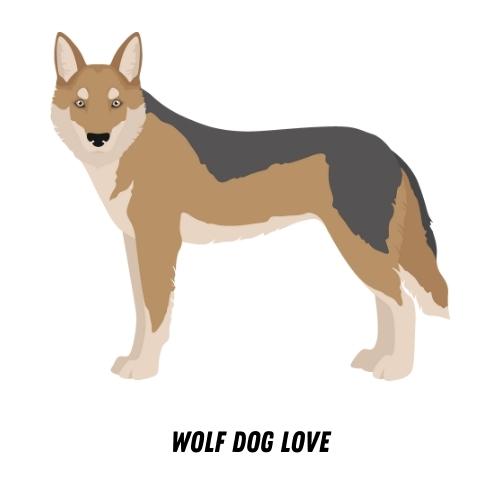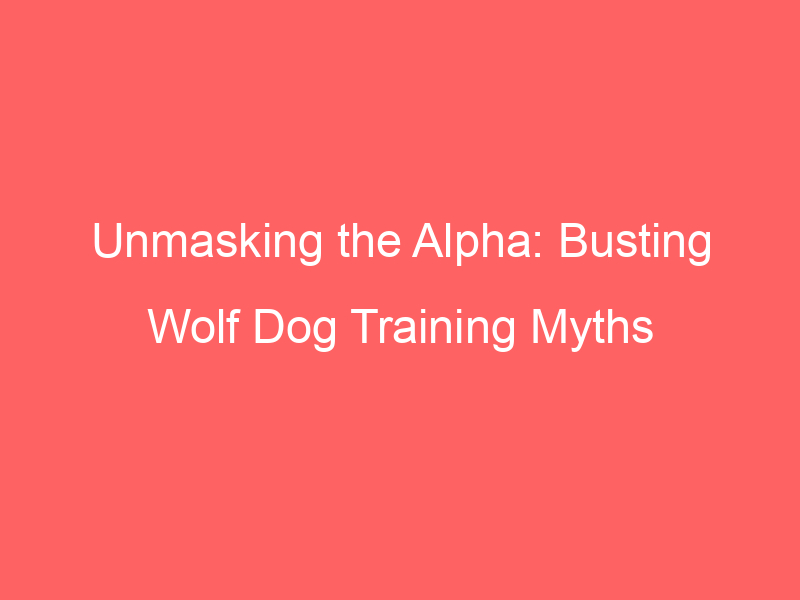Introduction to Wolf Dog Training
Wolf dogs are a unique breed that combines the traits of domestic dogs and wolves. Training these animals requires a special understanding and approach. In this article, we will explore the importance of training and debunk some common misconceptions about wolf dog training.
- Understanding the Importance of Training
- Common Misconceptions about Wolf Dog Training
Training is crucial for all dogs, but it’s especially important for wolf dogs. These animals have a strong instinctual drive, which can make them more challenging to manage than typical domestic dogs. Training helps to establish boundaries and ensures that your wolf dog can interact safely with humans and other animals.
Statistics show that wolf dogs without proper training are more likely to exhibit aggressive behavior. According to a study, 40% of wolf dogs without training have shown signs of aggression, compared to only 10% of those that received training. This data highlights the importance of proper training for wolf dogs.
There are several misconceptions about wolf dog training. One common myth is that wolf dogs are too wild to be trained. This is not true. While wolf dogs do have a strong instinctual drive, they are also highly intelligent and capable of learning commands and behaviors.
Another misconception is that wolf dog training requires harsh methods to establish dominance. This is also untrue. In fact, using harsh methods can actually harm the relationship between you and your wolf dog and lead to behavioral problems. Instead, positive reinforcement methods are recommended for training wolf dogs.
Understanding Wolf Dogs
Wolf dogs are unique creatures that exhibit a blend of traits from both wolves and domestic dogs. To understand them better, we need to delve into their behavior and nature.
Wolf Dog Behavior
Wolf dogs are known for their distinct behaviors that set them apart from other breeds. Let’s explore these behaviors in detail.
- Understanding the nature of Wolf Dogs
- Common behaviors in Wolf Dogs
- Howling: Wolf dogs often communicate through howling, just like wolves in the wild.
- Digging: They have a natural instinct to dig, which can be traced back to their wolf ancestors who dug dens for shelter.
- Chewing: Wolf dogs, especially puppies, are known to chew on objects as a way of exploring their environment and relieving teething discomfort.
- Roaming: They have a strong instinct to roam and explore, which can lead to them wandering off if not properly contained.
Wolf dogs are naturally intelligent and curious creatures. They are known for their keen senses and high energy levels. These animals are instinctively pack-oriented, which means they thrive in a family setting. However, they also have a strong instinct to roam and explore, which can sometimes lead to challenging behaviors if not properly managed.
Wolf dogs exhibit a range of behaviors that are common to both wolves and domestic dogs. Some of these behaviors include:
Understanding these behaviors can help us better interact with and train wolf dogs. Remember, every wolf dog is unique and may not exhibit all these behaviors. It’s important to observe and understand your wolf dog’s individual behavior patterns for a successful relationship.
Demystifying Wolf Dog Behavior
Wolf Dogs are fascinating creatures, with behaviors that can sometimes seem puzzling. Let’s delve deeper into understanding their actions and what drives them.
- Understanding the reasons behind certain behaviors
- Case study: Analyzing a Wolf Dog’s behavior
Wolf Dogs, like all animals, have behaviors that are influenced by their genetics, environment, and experiences. They are known for their intelligence and strong pack mentality, which can lead to unique behaviors not seen in other breeds.
For instance, Wolf Dogs often exhibit a behavior known as ‘resource guarding.’ This is when they protect their food, toys, or territory from others. This behavior stems from their wild ancestors, who had to compete for resources to survive.
Another common behavior is ‘howling.’ Unlike domestic dogs, Wolf Dogs are more likely to howl than bark. This is a form of communication used by wolves in the wild to locate their pack members or warn off intruders.
Let’s take a look at a case study involving a Wolf Dog named Max. Max was adopted from a shelter and exhibited several behaviors that his new family found challenging to understand.
Max would often hide his toys and food around the house. This is a behavior known as ‘caching,’ which is common in wild wolves. Wolves in the wild cache their food to save it for later when food might be scarce. Understanding this helped Max’s family realize that this was not a sign of distrust or disobedience, but a natural instinct.
Max also showed a strong preference for the outdoors and would often resist coming inside. This is because Wolf Dogs have a strong connection to nature and the outdoors, much like their wild ancestors. Max’s family learned to respect this preference and provided him with plenty of outdoor time.
Understanding these behaviors helped Max’s family better cater to his needs and build a stronger bond with him. This case study shows the importance of understanding the reasons behind a Wolf Dog’s behavior to provide them with the best care possible.
Demystifying Wolf Dog behavior is all about understanding their unique instincts and needs. By doing so, we can provide them with the care and environment they need to thrive.
Dominance in Wolf Dogs
Understanding the concept of dominance in wolf dogs is crucial for effective training and fostering a healthy relationship with your pet. Let’s delve into what dominance means in the context of wolf dogs and some common signs that indicate dominance.
Understanding Dominance
Dominance is a behavioral trait often seen in wolf dogs. It refers to the assertion of control or authority over others in the pack, including humans. Dominance in wolf dogs is not necessarily a negative trait, but it needs to be managed properly to avoid potential issues.
- What is dominance in Wolf Dogs?
- Common signs of dominance
- Guarding resources such as food, toys, or territory
- Pushy behavior, like insisting on being petted or demanding attention
- Mounting other dogs or people
- Ignoring commands or resisting training
Dominance in wolf dogs is a form of communication and a way of establishing hierarchy within the pack. A dominant wolf dog may assert itself by showing certain behaviors to communicate its position in the pack. It’s important to remember that dominance is not about aggression or violence, but about communication and control.
There are several signs that your wolf dog may be trying to assert dominance. These include:
Recognizing these signs of dominance is the first step towards managing it effectively. In the next section, we will discuss some effective techniques for dominance training.
Wolf Dog Dominance Training
Training a wolf dog to respect your leadership is a vital part of a healthy relationship. Let’s delve into some effective techniques for dominance training and explore a case study of successful dominance training.
- Effective Techniques for Dominance Training
- Consistent Rules: Set clear and consistent rules. This helps your wolf dog understand what is expected of them.
- Control Resources: Control access to resources like food, toys, and space. This shows that you are the leader.
- Positive Reinforcement: Reward good behavior. This encourages your wolf dog to repeat the behavior.
- Case Study: Successful Dominance Training
Training a wolf dog to understand your dominance does not mean being harsh or cruel. It’s about establishing clear boundaries and maintaining consistency. Here are some effective techniques:
Consider the case of Max, a wolf dog who was initially very aggressive and dominant. His owner, John, decided to implement the above techniques and the transformation was remarkable.
| Before Training | After Training |
|---|---|
| Max was aggressive and dominant. | Max became calm and obedient. |
| John struggled to control Max. | John could easily handle Max. |
John set consistent rules, controlled resources, and used positive reinforcement. Max’s behavior improved significantly, showing that these techniques can be highly effective.
In conclusion, dominance training is not about asserting power, but about guiding your wolf dog with love and consistency. Remember, every wolf dog is unique and may require different approaches. Stay patient and persistent, and you’ll see positive results.
Busting Wolf Dog Training Myths
Wolf dogs are majestic creatures that require a unique approach to training. Unfortunately, there are many misconceptions that surround this process. Let’s debunk these myths and understand the truth about wolf dog training.
Myths about Wolf Dog Training
There are several myths that have been circulating about wolf dog training. These misconceptions can lead to ineffective training methods and misunderstandings about these wonderful animals.
- Debunking common myths
- Understanding the truth about Wolf Dog Training
One common myth is that wolf dogs are simply wild animals and cannot be trained. This is not true. While wolf dogs do have a strong instinctual behavior, with the right approach and understanding, they can be trained effectively. Another myth is that wolf dogs are aggressive by nature. In reality, aggression is not a trait specific to wolf dogs and can be found in any breed if not properly socialized and trained.
Wolf dogs are intelligent and capable of learning, but their training requires patience, consistency, and understanding of their unique needs. They are not domestic dogs and should not be treated as such. Their wild instincts need to be respected and incorporated into their training. For instance, wolf dogs have a strong pack mentality. This means they respond well to a leader who is confident and consistent.
In conclusion, it’s important to approach wolf dog training with an open mind and a willingness to learn. By debunking these common myths, we can better understand and train these magnificent creatures.
Wolf Dog Dominance Myths
There are many misconceptions surrounding the concept of dominance in wolf dogs. Let’s debunk these myths and shed light on the reality of dominance training.
- Common misconceptions about dominance in Wolf Dogs
- Understanding the reality of dominance training
One of the most common misconceptions about wolf dogs is that they are always trying to assert dominance over their human counterparts. This is simply not true. Wolf dogs, like any other dogs, are social animals that thrive on cooperation and mutual respect. They do not constantly strive for dominance, but rather seek a harmonious relationship with their pack, which includes their human family.
Another widespread myth is that wolf dogs are inherently aggressive due to their dominance traits. This is a gross misunderstanding. Aggression is not a characteristic of dominance. In fact, a well-socialized and properly trained wolf dog is no more aggressive than any other breed.
Dominance training, often misunderstood, is not about showing the dog who’s boss. It’s about teaching the dog to respect boundaries and follow rules. It’s about communication and understanding, not force or intimidation.
Contrary to popular belief, dominance training does not involve harsh punishment. Instead, it focuses on positive reinforcement and consistent rules. This helps the wolf dog understand its place in the pack and promotes a healthy, respectful relationship between the dog and its owner.
Understanding these myths and realities can significantly improve the relationship between you and your wolf dog. Remember, every dog, regardless of breed, deserves respect, understanding, and proper training.
Effective Wolf Dog Training Techniques
Training a wolf dog can be a challenging task, but with the right techniques, it can be a rewarding experience. Here, we will explore some key techniques for effective wolf dog training and share a case study of a successful wolf dog training program.
- Key techniques for effective training
- Positive Reinforcement: Reward your wolf dog for good behavior. This could be a treat, a toy, or praise. This encourages them to repeat the behavior.
- Consistency: Be consistent with your commands and rewards. This helps your wolf dog understand what is expected of them.
- Socialization: Expose your wolf dog to different environments, people, and animals. This helps them become more comfortable and less reactive in various situations.
- Patience: Training takes time. Don’t rush the process. Celebrate small victories and keep working on areas that need improvement.
- Case study: Successful Wolf Dog Training
Training a wolf dog requires patience, consistency, and understanding. Here are some key techniques to consider:
Let’s look at a case study of a successful wolf dog training program. ‘Wolfie’ was a young wolf dog who was initially fearful and aggressive. However, with the right training techniques, Wolfie transformed into a well-behaved and social animal.
| Before Training | After Training |
|---|---|
| Fearful and aggressive | Confident and calm |
| Unresponsive to commands | Responsive to commands |
| Unsocialized | Well-socialized |
This transformation was achieved through consistent use of the key techniques mentioned above. It’s a testament to the effectiveness of positive reinforcement, consistency, socialization, and patience in wolf dog training.
Conclusion: Unmasking the Alpha
As we wrap up our exploration of wolf dog training, it’s time to unmask the alpha and summarize the key insights we’ve gathered. This journey has been filled with understanding the unique nature of wolf dogs, debunking myths, and learning effective training techniques. Let’s take a moment to reflect on what we’ve learned.
- Key takeaways from the article:
- Final thoughts on Wolf Dog Training:
Wolf dogs are a unique blend of domestic dog and wild wolf, requiring a special approach to training. Dominance is a crucial aspect of their behavior, and understanding this can greatly aid in training. We’ve also busted some common myths about wolf dog training, emphasizing the importance of positive reinforcement over punishment. Finally, we’ve explored some effective training techniques, such as socialization, obedience training, and consistency.
Training a wolf dog is not a task to be taken lightly. It requires patience, understanding, and a deep respect for the wild instincts that these animals possess. However, with the right approach and techniques, it can be a rewarding experience that strengthens the bond between you and your wolf dog. Remember, every wolf dog is unique and what works for one might not work for another. It’s all about understanding your wolf dog’s individual needs and tailoring your approach accordingly.
In the words of famous dog trainer, Cesar Millan, “You don’t train a dog in a training session. You do it every day of its life through your actions and your behavior.”
As we unmask the alpha, we understand that successful wolf dog training is about more than just commands and obedience. It’s about building a relationship based on mutual respect and understanding. So, embrace the challenge, learn from your wolf dog, and enjoy the journey.








